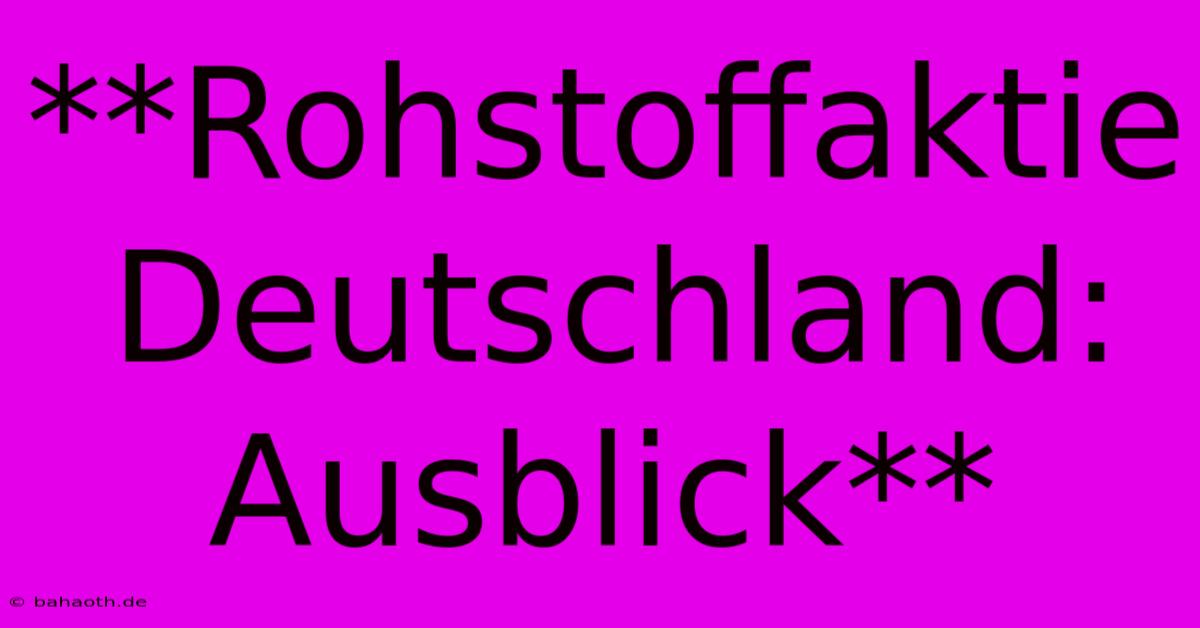**Rohstoffaktie Deutschland: Ausblick**

Discover more detailed and exciting information on our website. Click the link below to start your adventure: Visit Best Website **Rohstoffaktie Deutschland: Ausblick**. Don't miss out!
Table of Contents
Rohstoffaktie Deutschland: Ausblick – Chancen und Risiken im Überblick
Hey Leute! Let's talk about Rohstoffaktien in Deutschland – the outlook, the good, the bad, and the ugly. I've been knee-deep in this stuff for years, and let me tell you, it's been a rollercoaster. Plenty of wins, but also some epic fails. Think I haven't learned a thing or two along the way? Think again!
Der deutsche Rohstoffmarkt: Ein Überblick
Germany, right? Not exactly known as a massive raw materials powerhouse like, say, Australia. But we've got some key players, and understanding them is crucial for any investor looking at Rohstoffaktien. We're talking about companies involved in everything from Metalle (think steel, aluminum – crucial for construction and manufacturing) to Chemikalien (the backbone of countless industries). Then there's the whole Energie sector, which is undergoing a HUGE transformation right now. That's a lot of moving parts, folks.
My biggest mistake? Jumping into a company solely based on hype. Remember that one lithium miner everyone was raving about a few years back? Yeah, that one. Lost a chunk of change there. Lesson learned: Due diligence is key. Don't just follow the crowd.
Welche Faktoren beeinflussen den Ausblick?
So, what's shaping the future of Rohstoffaktien in Germany? A few major factors are at play:
Geopolitische Risiken:
This is HUGE. Global events – wars, trade disputes, political instability – all have a major impact. Think about the war in Ukraine and its effect on energy prices. It's a wild ride, and you need to be aware of the geopolitical landscape. Seriously. Ignoring it is a recipe for disaster.
Nachhaltigkeit:
Sustainability is becoming increasingly important, especially in Europe. Investors are looking for companies committed to environmental, social, and governance (ESG) factors. This means companies that are transparent about their environmental impact and social responsibility – it's not just a buzzword anymore.
Innovation und Technologie:
New technologies and innovative processes are constantly changing the game. Companies that embrace innovation and adapt to new challenges will be better positioned for long-term success. This is especially true in the energy sector, with the push towards renewable energy sources. Think wind power, solar power, and more.
Konjunktur:
The overall economic climate plays a big role. A strong economy generally leads to higher demand for raw materials, boosting the performance of Rohstoffaktien. Conversely, a downturn can severely impact the sector. This means you have to keep an eye on economic indicators too.
Investitionsstrategie: Tipps für den Erfolg
Okay, so you want to invest in Rohstoffaktien in Germany? Here's what I've learned:
- Diversifizieren Sie Ihr Portfolio: Don't put all your eggs in one basket. Spread your investments across different companies and sectors to minimize risk.
- Langfristige Perspektive: Rohstoffaktien can be volatile. A long-term investment strategy is often the best approach. This is not a get-rich-quick scheme, folks.
- Marktforschung: Thorough research is absolutely essential. Understand the companies you're investing in, their business models, and the risks involved.
- Risikomanagement: Always be aware of the potential risks. Investing in Rohstoffaktien can be risky, so manage your risk accordingly. I can't stress this enough.
Fazit: Chancen und Herausforderungen
Investing in Rohstoffaktien in Germany presents both opportunities and challenges. While the market can be volatile, careful research, a long-term perspective, and a well-diversified portfolio can help you navigate the risks and potentially reap the rewards. Remember my mistakes – they were expensive lessons, but hopefully, they'll save you some money! Good luck!

Thank you for visiting our website wich cover about **Rohstoffaktie Deutschland: Ausblick**. We hope the information provided has been useful to you. Feel free to contact us if you have any questions or need further assistance. See you next time and dont miss to bookmark.
Featured Posts
-
Luege Oder Wahrheit Barca Star Spricht
Nov 27, 2024
-
Wirtz Bayer Siegt 5 0 In Leverkusen
Nov 27, 2024
-
Vorweihnachtlicher Lottogewinn
Nov 27, 2024
-
Euromillions Ergebnisse 26 11 2024
Nov 27, 2024
-
Jugendliche And Ehe Seminar In Mannheim
Nov 27, 2024
